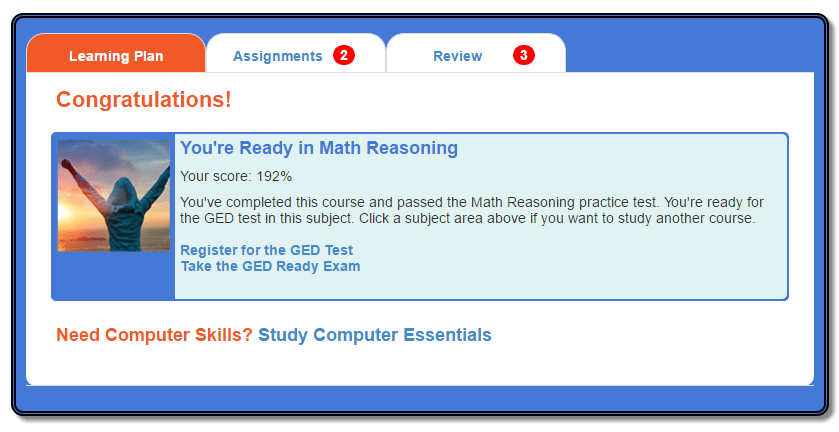
What’s on the GED® Maths Test?
According to the GED Testing Service, the GED Maths test consists of two parts. It measures problem solving skills, the ability to interpret charts, tables, and graphs. It also requires students to solve some real life maths problems.
The Mathematical Reasoning test contains the following
- Number operations and number sense (20-30%)
- Measurement and geometry (20-30%)
- Data analysis, statistics, and probability (20-30%)
- Algebra, functions, and patterns (20-30%)
There is no trigonometry and no calculus. A calculator is provided on-screen, where one is allowed. You may not take a calculator or any personal belongings into the exam room. A formula sheet is provided and students are given a white board and marker to do rough calculations.
The test is 115 minutes and it is divided into two parts:
Part 1: 5 test questions. No calculator allowed
Part 2: 41 test questions. Calculator provided on-screen may be used where required. Only the on-screen calculator may be used in the exam. You may not take your own.
The GED Math Tests two content areas:
- Quantitative Problem Solving (45%) – problems with positive and negative whole numbers, fractions, decimals, percentages, ratios, proportions, exponents, roots, data and statistics and geometric measurement
- Algebraic Problem Solving (55%) – includes equations, linear equations, quadratic equations, expressions, polynomials, , inequalities, patterns, graphs and functions. You will be tested on solving, and graphing skills in algebra.
I have overcome my fear of Math thanks to the GED®. I passed it on my first attempt and that was a huge achievement for me.
Sai Pillay
There are five types of questions on the GED Mathematical Reasoning exam:
- Multiple Choice
- Fill-in-the-blank
- Hot-spot
- Drag and drop
- Drop-down
To succeed on the GED® Math Test you need a strong grasp on problem-solving, reasoning and analytical skills. You must be able to draw and interpret information from both written and visual mathematical data. This may include diagrams, tables, graphs or charts. You must be able to understand and apply mathematical concepts in real-life contexts.
My daughter struggled with Maths at school. Will she cope with the GED Maths?

Many people worry about maths. It is a subject that seems to cause many students a lot of anxiety and usually it is because they have struggled with it in the past.
The GED® is designed to help people of all ages obtain a high school equivalency credential.
The online GED® course, that we offer, helps learners overcome their struggles and master the GED Maths. It is designed for self-study and therefore most students are able to master it without any outside assistance.
The online tutor, Leonard explains new concepts, answers typical questions and teaches the students!
GED Maths Success – as easy as ABC
A – Assessment
Initially, when a student starts the online study programme for each subject, it gives them a practice test of 30 questions to assess at which level the learner should start in this subject.
Then, it then gives all students some revision in basics – things like whole numbers, fractions, percentages etc …which are junior school level maths lessons.
Students who have reached about grade 10 level usually cope very comfortably with the GED® Maths. Those who have a lower level simply take longer to work through the course as they need more revision and more practice until they master the new maths skills they learn.
B – Builds a Foundation and Builds Confidence
This revision process has a double benefit – firstly, it fills in any ‘gaps’ in a student’s understanding of these basic concepts and skills in order to build a firm foundation, before moving on to high school level maths.
Secondly, by going back to basics, the learner easily masters these concepts and this builds self-confidence. Many of our parents and students say that the GED® course was such a healing tool for the student’s damaged self-esteem and low self-confidence.
How the Online GED® Prep Course uses Positive Emotions to Optimise Learning
C- Customised
Students who are strong in Maths will do less revision than students whose maths skills are found to be somewhat weaker. In this way, the students’ courses are customised according to their needs and abilities
Finally, the course is absolutely self-paced, so a student only moves on after s/he has MASTERED the new concept or skill being taught.
It is not like the school system, where some learners haven’t yet grasped something and yet the teacher and the rest of the class move on to a new lesson. In this way, a student can work at his or her own pace. At the end, the study course will actually tell the student when they are ready for the test. It says: “Congratulations, you are ready in Math Reasoning,” as shown in the image below, if the student’s scores are good enough.

If the scores are not good enough, it will say “You are almost there, but first review the following lessons…” and it will list the lessons to review.
Less Stress
There are no set exam dates and no deadlines. Students only book and write their GED® maths exam when they are ready. They can see when they have completed the course and scored well on the lessons, quizzes and practice tests.
Students must also first take a GED Ready® test. This is an optional half-length practice test, offered by the GED Testing Service. More about that Online GED Test Booking
All of the above, helps to develop not only a student’s maths skills, but also helps them overcome their maths anxiety and build their confidence. Then they can walk into the test centre with a positive attitude. The process is designed to set students up for success!

GED Maths Success
Hi Shirley
My son was in [Name Removed] High School till grade 10 and always battled to understand maths. In grade 10, first term, they had a maths teacher for the first month and then he resigned. Then they had another teacher for 2 months and then the teacher passed away, from cancer. Then there were over 55 learners in the maths class. This was in Afrikaans.
Since he did GED®, he said it is the first time he has understood maths and even in English. His marks are far better than what he achieved in school. The way GED teaches you to do the maths and to understand is much better than he learned in school. He even had extra classes in school. In school exams they try to catch you out. In GED they teach you how to understand maths and what to do to be able to get to the right answer.
~ Deon, January 2017
Click here for more customer reviews from parents whose children had a very positive GED® experience, after a negative school experience.
Test it out! Free Trial
Contact us to take a 5-day free trial to test out the online system, especially the Maths and see how you like it.
What’s on the GED® Test?
See what’s on the GED® Test for each subject.



